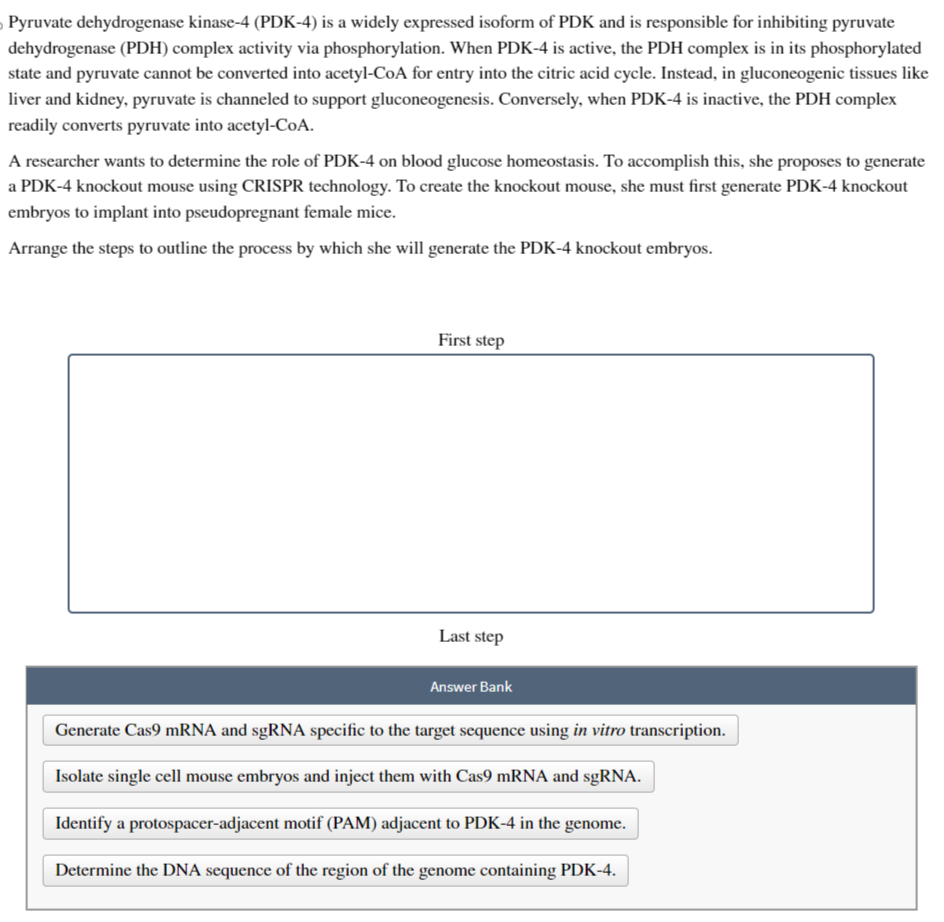yruvate dehydrogenase kinase-4 (PDK-4) is a widely expressed isoform of PDK and is responsible for inhibiting pyruvate ehydrogenase (PDH) complex activity via phosphorylation. When PDK-4 is active, the PDH complex is in its phosphorylated ate and pyruvate cannot be converted into acetyl-CoA for entry into the citric acid cycle. Instead, in gluconeogenic tissues like ver and kidney, pyruvate is channeled to support gluconeogenesis. Conversely, when PDK-4 is inactive, the PDH complex eadily converts pyruvate into acetyl-CoA. researcher wants to determine the role of PDK-4 on blood glucose homeostasis. To accomplish this, she proposes to generate PDK-4 knockout mouse using CRISPR technology. To create the knockout mouse, she must first generate PDK-4 knockout mbryos to implant into pseudopregnant female mice. rrange the steps to outline the process by which she will generate the PDK-4 knockout embryos. First step Last step Answer Bank Generate Cas9 mRNA and sgRNA specific to the target sequence using in vitro transcription. Isolate single cell mouse embryos and inject them with Cas9 mRNA and sgRNA. Identify a protospacer-adjacent motif (PAM) adjacent to PDK-4 in the genome. Determine the DNA sequence of the region of the genome containing PDK-4.
yruvate dehydrogenase kinase-4 (PDK-4) is a widely expressed isoform of PDK and is responsible for inhibiting pyruvate ehydrogenase (PDH) complex activity via phosphorylation. When PDK-4 is active, the PDH complex is in its phosphorylated ate and pyruvate cannot be converted into acetyl-CoA for entry into the citric acid cycle. Instead, in gluconeogenic tissues like ver and kidney, pyruvate is channeled to support gluconeogenesis. Conversely, when PDK-4 is inactive, the PDH complex eadily converts pyruvate into acetyl-CoA. researcher wants to determine the role of PDK-4 on blood glucose homeostasis. To accomplish this, she proposes to generate PDK-4 knockout mouse using CRISPR technology. To create the knockout mouse, she must first generate PDK-4 knockout mbryos to implant into pseudopregnant female mice. rrange the steps to outline the process by which she will generate the PDK-4 knockout embryos. First step Last step Answer Bank Generate Cas9 mRNA and sgRNA specific to the target sequence using in vitro transcription. Isolate single cell mouse embryos and inject them with Cas9 mRNA and sgRNA. Identify a protospacer-adjacent motif (PAM) adjacent to PDK-4 in the genome. Determine the DNA sequence of the region of the genome containing PDK-4.
Biochemistry
6th Edition
ISBN:9781305577206
Author:Reginald H. Garrett, Charles M. Grisham
Publisher:Reginald H. Garrett, Charles M. Grisham
Chapter19: The Tricarboxylic Acid Cycle
Section: Chapter Questions
Problem 22P: Study Figure 19.18 and decide which of the following statements is false. Pyruvate dehydrogenase is...
Related questions
Question

Transcribed Image Text:Pyruvate dehydrogenase kinase-4 (PDK-4) is a widely expressed isoform of PDK and is responsible for inhibiting pyruvate
dehydrogenase (PDH) complex activity via phosphorylation. When PDK-4 is active, the PDH complex is in its phosphorylated
state and pyruvate cannot be converted into acetyl-CoA for entry into the citric acid cycle. Instead, in gluconeogenic tissues like
liver and kidney, pyruvate is channeled to support gluconeogenesis. Conversely, when PDK-4 is inactive, the PDH complex
readily converts pyruvate into acetyl-CoA.
A researcher wants to determine the role of PDK-4 on blood glucose homeostasis. To accomplish this, she proposes to generate
a PDK-4 knockout mouse using CRISPR technology. To create the knockout mouse, she must first generate PDK-4 knockout
embryos to implant into pseudopregnant female mice.
Arrange the steps to outline the process by which she will generate the PDK-4 knockout embryos.
First step
Last step
Answer Bank
Generate Cas9 mRNA and sgRNA specific to the target sequence using in vitro transcription.
Isolate single cell mouse embryos and inject them with Cas9 mRNA and sgRNA.
Identify a protospacer-adjacent motif (PAM) adjacent to PDK-4 in the genome.
Determine the DNA sequence of the region of the genome containing PDK-4.
Expert Solution
This question has been solved!
Explore an expertly crafted, step-by-step solution for a thorough understanding of key concepts.
This is a popular solution!
Trending now
This is a popular solution!
Step by step
Solved in 2 steps

Recommended textbooks for you

Biochemistry
Biochemistry
ISBN:
9781305577206
Author:
Reginald H. Garrett, Charles M. Grisham
Publisher:
Cengage Learning

Biochemistry
Biochemistry
ISBN:
9781305577206
Author:
Reginald H. Garrett, Charles M. Grisham
Publisher:
Cengage Learning